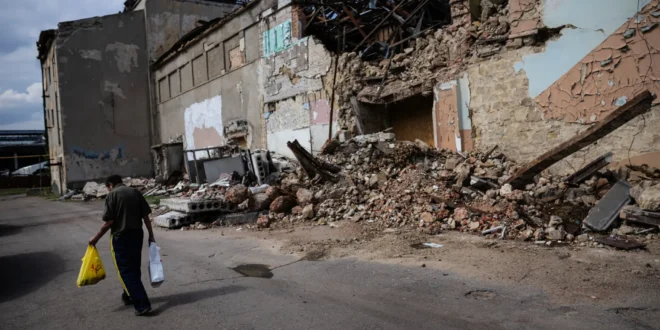Washington’s push to negotiate an end to the war has raised concerns the Trump administration will make concessions to Moscow that Kyiv finds unacceptable.
A man carrying two shopping bags passes a damaged building.
A town in the Donetsk region of Ukraine in June. The Trump administration has been pushing for an end to the war that began with Russia’s full-scale invasion of Ukraine in 2022.Credit…David Guttenfelder/The New York
Ukraine and its European allies sought on Sunday to present a united front ahead of a meeting this week between President Trump and President Vladimir V. Putin of Russia that risks sidelining Kyiv in future peace talks.
“The path to peace in Ukraine cannot be decided without Ukraine,” read a statement released early Sunday by seven European leaders, including President Emmanuel Macron of France and Chancellor Friedrich Merz of Germany.
President Volodymyr Zelensky of Ukraine was quick to endorse their statement, writing hours later on social media that he was “grateful to everyone who stands with Ukraine and our people today for the sake of peace in Ukraine, which is defending the vital security interests of our European nations.”
The coordinated statements came after Mr. Zelensky engaged on Saturday in a series of calls with European leaders. That same day, two senior Ukrainian officials and their European counterparts met with top American officials outside London to try to gauge Moscow’s negotiating position and to press Ukraine’s case ahead of the Trump-Putin summit on Friday in Alaska.
European leaders pose for a group photo.
President Volodymyr Zelensky of Ukraine, center, last month with European leaders at a conference. Ukraine and its European allies have sought to present a united front ahead of a meeting between President Trump and President Vladimir V. Putin of Russia.Credit…Mauro Scrobogna/LaPresse, via Associated Press
The calls and the meeting near London made clear that Kyiv was once again trying to rally its European allies as Washington pushes to independently negotiate an end to the war with Russia, raising concerns that the Trump administration will make concessions to Moscow that Kyiv cannot accept. Ukraine is also determined not to let Russia set the terms and structure of future peace talks.
In their statement, the European leaders said that “meaningful negotiations can only take place” after a cease-fire or a reduction in hostilities has been put in effect — a position long held by Ukraine but one that Russia has consistently rejected.
The European leaders also said that they “remain committed to the principle that international borders must not be changed by force” and that the current front line “should be the starting point of negotiations.” That language amounted to an implicit rejection of Mr. Trump’s recent suggestion that a cease-fire deal could include some “swapping of territories.”
Kaja Kallas, the European Union’s foreign policy chief, said she would convene an emergency meeting of the bloc’s foreign ministers on Monday to discuss next steps.
“Any deal between the U.S. and Russia must have Ukraine and the E.U. included, for it is a matter of Ukraine’s and the whole of Europe’s security,” she told the Agence France-Presse news agency on Sunday.
The Trump-Putin summit was announced after Steve Witkoff, the U.S. president’s envoy, met with the Russian leader last week in Moscow. After the meeting, Mr. Trump briefed European leaders and described a proposal by Mr. Putin that two senior European officials said involved giving Russia the entire Donbas region of Ukraine, an area his forces do not entirely control.
Mr. Zelensky warned on Saturday that he would not accept any deal requiring Ukraine to hand over territory that Russia does not currently occupy.
“Any decisions made against us, any decisions made without Ukraine, are at the same time decisions against peace,” Mr. Zelensky said. “They will bring nothing. These are dead decisions; they will never work.”
Constant Méheut reports on the war in Ukraine, including battlefield developments, attacks on civilian centers and how the war is affecting its people.
Our Coverage of the War in Ukraine
Trump-Putin Meeting: President Trump said he would meet with President Vladimir Putin of Russia, as he tries to secure a deal to end the war. President Volodymyr Zelensky of Ukraine rejected the idea of ceding land after Trump suggested that a peace deal could include “some swapping of territories.” Here’s what to know.
Putin’s Quiet Technocrat: Sergei Kiriyenko enacted Putin’s wartime agenda, while gaining power from a Kremlin aide who balked at the invasion of Ukraine. Read takeaways from our reporting on Kiriyenko.
Russia’s Economy: The Russian economy was slowing even before Trump’s latest threats. But the Kremlin has enough money to keep fighting in Ukraine.
Arrests in Ukraine: Ukrainian authorities arrested a number of officials on suspicion of corruption in relation to what they called a “large scale” bribery scheme involving military procurement.
Fleeing Domestic Violence: The women’s shelter in Sumy, Ukraine, near the Russian border, has become a refuge from abusive men that also takes in vulnerable poor mothers. Yet even as they flee violence at home, the women are desperate to escape the encroaching war.
Spying Guard: A Norwegian man has been accused of leaking sensitive information about U.S. embassy staff members and threatening Norway’s national interests on behalf of Russia and Iran, according to prosecutors.
How We Verify Our Reporting
Our team of visual journalists analyzes satellite images, photographs, videos and radio transmissions to independently confirm troop movements and other details.
We monitor and authenticate reports on social media, corroborating these with eyewitness accounts and interviews. Read more about our reporting efforts.
 DAILY UPDATE DAILY UPDATE
DAILY UPDATE DAILY UPDATE
